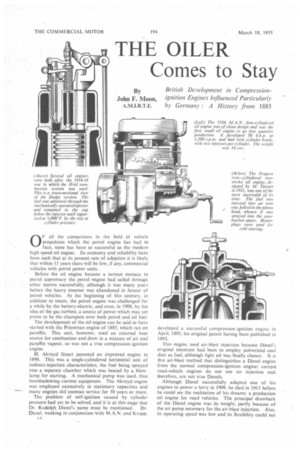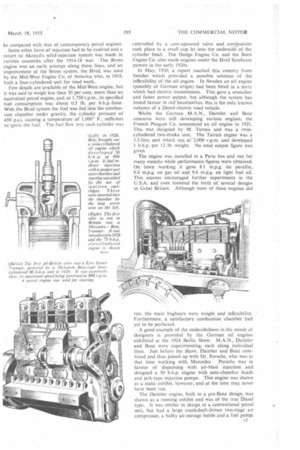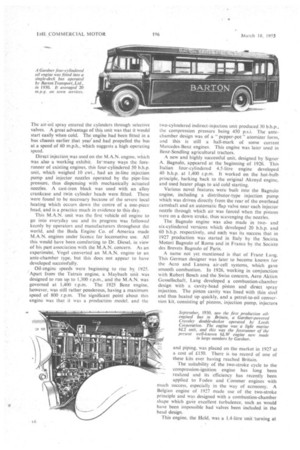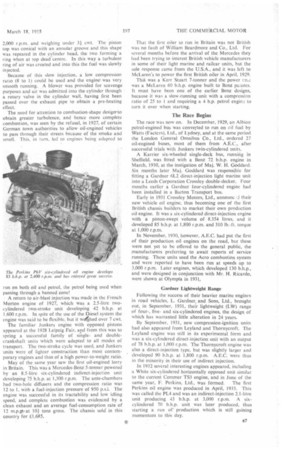THE OILER Comes to Stay
Page 104

Page 105

Page 106

Page 107

If you've noticed an error in this article please click here to report it so we can fix it.
OF all the competitors in the field of vehicle propulsion which the petrol engine has had to face, none has been so successful as the modern high-speed oil engine. Its economy and reliability have been such that at its present rate of adoption it is likely that within 15 years there will be few, if any, commercial vehicles with petrol power units.
Before the oil engine became a serious menace to petrol supremacy the petrol engine had sailed through other storms successfully, although it was many years before the heavy steamer was abandoned in favour of petrol vehicles. At the beginning of this century, in addition to steam, the petrol engine was challenged for a while by the battery-electric, and even, in 1908, by the idea of the gas turbine, a source of power which may yet prove to be the champion over both petrol and oil fuel.
The development of the oil engine can be said to have started with the Priestman engine of 1885, which ran on paraffin. This unit, however, used an external heat source for combustion and drew in a mixture of air and paraffin vapour, so was not a true compression-ignition engine.
H. Akroyd Stuart patented an improved engine in 1890. This was a single-cylindered horizontal unit of indirect-injection characteristics, the fuel being sprayed into a separate chamber which was heated by a blowlamp for starting. A mechanical pump was used, thus foreshadowing current equipment. The Akroyd engine was employed extensively in stationary capacities and .....-. many engines did yeoman service for 30 years or more. The problem of self-ignition caused by cylinder pressure had yet to be solved, and it is at this stage that Dr. Rudolph Diesel's name must be mentioned. Dr. Diesel, working in conjunction with M.A.N. and Krupp, developed a successful compression-ignition engine in April, 1895, his original patent having been published in 1892.
'This engine used air-blast injection because Diesel's original intention had been to employ pulverized coal dust as fuel, although light oil was finally chosen, It is this air-blast method that distinguishes a Diesel engine from the normal compression-ignition engine: current road-vehicle engines do not use air injection and, therefore, are not true Diesels.
Although Diesel successfully adapted one of his engines to power a lorry in 1909, he died in 1913 before he could see the realization of his dreams: a production oil engine for road vehicles. The principal drawback of the Diesel engine was its weight, partly because of the air pump necessary for the air-blast injection. Also, its operating speed was low and its flexibility could not be compared with that of contemporary petrol engines Some other form of injection had to be evolved and a return to Akroyd's solid-injection system was made in various countries after the 1914-18 war. The ,Brons engine was an early attempt along these lines, and an improvement of the Brons system, the Hvid, was used by the Mid-West Engine Co. of America who, in 1918, built a four-cylindered unit for road work.
Few details are available, of the Mid-West engine, but it was said to weigh less than 30 per cent. more than an equivalent petrol engine, and, at 1,750Ir.p.m., its specified fuel consumption was about 0.5 lb. per b.h.p.-hour. With the Hvid system the fuel was fed into the combustion chamber under gravity, the cylinder pressure of 450 p.s.i. causing a temperature of 1,000° F., sufficient to ignite the fuel. The fuel flow into each cylinder was
controlled by a cam-operated valve and combustion took place in a small cup let into the underside of the cylinder head. The Dodge Engine Co. and the Boos Engine Co. also made engines under the Hvid Syndicate patents in the early 1920s, In May, 1920, a report reached this country from Sweden which provided a possible solution of the inflexibility of the oil engine. In Sweden an oil engine (possibly of German origin) had been fitted in a lorry which had electric transmission. This gave a smoother and faster power output, but although the system has found favour in rail locomotA7es, this is the only known instance of a Diesel-electric road vehicle.
Whilst the German M.A.N., Daimler and Benz concerns were still developing various engines, the French Peugeot Co. announced an oil engine in 1921. This was designed by M. Tatrais and was a twincylindered two-stroke unit. The Tatrais engine was a 3.5-litre unit which ran at2,000 r.p.m. and developed b.h.p. per 12 lb. weight. No total output figure was given.
The engine was installed in a Paris bus and ran for many months while performance figures were obtained. On town working it gave 8.1 m.p.g. on paraffin, 8.6 m.p.g. on gas oil and 9.6 m.p.g. on light fuel oil. This success encouraged further experiments in the U.S.A. and even fostered the birth of several designs in Great Britain. Although most of these engines did run, the main bugbears were weight and inflexibility. Furthermore, a satisfactory combustion chamber had yet to be perfected.
A good example of the undecidedness in the minds of designers is provided by the German oil engines exhibited at the 1924 Berlin Show. M.A.N., Daimler and Benz were experimenting, each along individual lines. Just before the Show, Daimler and Benz combined and thus joined up with Dr. Porsche, who was at that time working with Mercedes. Porsche was in favour of dispensing with air-blast injection and designed a 50 b.h.p. engine with ante-chamber heads and jerk-type injection pumps. This engine was shown as a static exhibit, however, and at the time may never have been run.
The Daimler engine, built to a pre-Benz design, was shown as a running exhibit and was of the true Diesel type. It was similar in design to a conventional petrol unit, but had a large crankshaft-driven two-stage air compressor, a bulky air-storage bottle and a fuel pump. The air-oil spray entered the cylinders through selective valves. A great advantage of this unit was that it would start easily when cold. The engine had been fitted in a bus chassis earlier that year and had propelled the bus at a speed of 60 m.p.h., which suggests a high operating speed.
Direct injection was used on the M.A.N. engine, which was also a working exhibit. In' many ways the forerunner of existing engines, this four-cylindered 50 b.h.p. unit, which weighed 10 cwt., had an in-line injection pump and injector nozzles operated by the pipe-line pressure, thus dispensing with mechanically actuated nozzles. A cast-iron block was used with an alloy crankcase and twin cylinder heads were fitted. These were found to be necessary because of the severe local heating which occurs down the centre of a one-piece head, and is a practice much in evidence to this day.
This M.A.N. unit was the first vehicle oil engine to go into everyday use and its progress was followed keenly by operators and manufacturers throughout the world, and the Buda Engine Co. of America made M.A.N. engines under licence for locomotive use. All this would have been comforting to Dr. Diesel, in view of his past association with the M.A.N. concern. As an experiment, Vogel converted an M.A.N. engine to an ante-chamber type, but this does not appear to have developed successfully. Oil-engine speeds were beginning to rise by 1925. Apart from the Tatrais engine, a Maybach unit was designed to run up to 1,300 r.p.m., and the M.A.N. was governed at 1,400 r.p.m. The 1925 Benz engine, however, was still rather ponderous, having a maximum speed of 800 r.p.m. The significant point about this engine was that it was a production model, and the two-cylindered indirect-injection unit produced 30 b.h.p., the compression pressure being 450 p.s.i. The antechamber design was of a " pepper-pot " atomizer form, and this is still a hall-mark of some current Mercedes-Benz engines. This engine was later used in Benz-Sendling agricultural tractors.
A new and highly successful unit, designed by Signor A. Bagnulo, appeared at the beginning of 1926. This Italian four-cylindered 4.5-litre engine developed 40 b.h.p. at 1,400 r.p.m. It worked on the hot-bulb principle, harking back to the original Akroyd engine, and used heater plugs to aid cold starting.
Various novel features were built into the Bagnulo engine, including a distributor-type injection pump which was driven directly from the rear of the overhead camshaft and an automatic flap valve near each injector nozzle through which air was forced when the pistons were on a down stroke, thus scavenging the nozzles.
The Bagnulo engine was also made in twoand six-cylindered versions which developed 20 b.h.p. and 60 b.h.p. respectively, and such was its success that in 1927 production was started in Italy by the Societa Motori Bagnulo of Rome and in France by the Societe des Brevets Bagnulo of Paris.
A name not yet mentioned is that of Franz Lang. This German designer was later to become known for the Acro and Lanova air-cell systems, which gave smooth combustion. In 1926, working in conjunction with Robert Bosch and the Swiss concern, Aero Aktien Gessellschaft, Lang developed a combustion-chamber design with a cavity-head piston and direct spray injection. The piston cavity was lined with thin steel and thus heated up quickly, and a petrol-to-oil conversion kit, consisting qf pistons, injection pump, injectors and piping, was placed on the market in 1927 at a cost of £150. There is no record of one of these kits ever having reached Britain.
The suitability of the two-stroke cycle to the compression-ignition engine has long been realized and its efficiency has recently been applied to Foden and Commer engines with much success, especially in the way of economy. A Belgian engine of 1927 made use of the two-stroke principle and was designed with a combustion-chamber shape which gave excellent turbulence, such as would have been impossible had valves been included in the head design.
This engine, the Held, was a 1.4-litre unit turning at 2,000 r.p.m. and weighing under 3 cwt. The piston top was conical with an annular groove and this shape was repealed in the cylinder head, the two forming a ring when at top deadeentre. In this way a turbulent ring of air was created and into this the fuel was slowly injected.
Because of this slow injection, a low compression ratio (8 to 1) could be used and the engine was very smooth running. A blower was provided for scavenge purposes and air was admitted into the cylinder through a rotary valve in the cylinder wall, having first been passed over the exhaust pipe to obtain a pre-heating effect.
The need for attention to combustion-shape desigrrto obtain greater turbulence, and hence more complete combustion, was seen by the refusal, in 1927, of certain German town authorities to allow oil-engined vehicles to pass through their streets because of the smoke and smell. This, in urn. led to engines being adapted to runon both oil and petrol, the petrol being used when passing through a banned zone!
A return to air-blast injection was made in the French Morton engine of 1927, which was a 2.5-litre twocylindered two-stroke unit developing 42 b.h.p. at 1.600 r.p.m. In spite of the use of the Diesel system the engine was said to be flexible, but it werghed over 7 cwt.
The familiar Junkers engine with opposed pistons appeared at the 1928 Leipzig Fair, and from this was to spring a successful family of singleand doublecrankshaft units which were adapted to all modes of transport. The two,stroke cycle was used, and Junkers units were of lighter construction than most contemporary engines and thus of a high power-to-weight ratio.
May of the same year saw the first oil-engined lorry in Britain. This was a Mercedes-Benz 5-tonner powered by an 8.5-litre six-cylindered indirect-injection unit developing 75 b.h.p. at 1,300 r.p.m. The ante-chambers had two-hole diffusers and the compression ratio was 12 to 1, with a fuel-injection pressure of 950 psi. The engine was successful in its tractability and low idling speed, and complete combustion was evidenced by a clean exhaust and an average fuel-consumption rate of 12 rn.p.gfp at 101 tons gross. The chassis sold' in this country for £1,685. 'That the first oiler to run in Britain was not British was no fault of William Beardmore and Co., Ltd. For several months before the arrival of the Mercedes they had been trying to interest British vehicle manufacturers in some of their light marine and railcar units, but the sole response came from the U.S.A., and it was left to McLaren's to power the first British oiler in April, 1929.
Thit was a Kerr Stuart 7-tonner and the power vrt.r was a McLaren 60 b.h.p. engine built to Benz pa:ents. It must have been one of the earlier Benz designs, because it was a slow-running unit with a compression ratio of 25 to 1 and requiring a 4 h.p. petrol engin...! to turn it over when starting.
The Race Begins
The race was now on. In December, 1929, an Albion petrol-engined bus was converted to run on oil fuel by Watts (Faetcrs), Ltd., of Lydney, and at the same period the London General Omnibus Co., Ltd., ordered 27 oil-engined buses, most of them from A.E.C., after successful trials with Junkers twin-cylindered units.
A Karrier six-wheeled single-deck bus, running in Sheffield, was fitted with a Benz 72 b.h.p. engine in March, 1930, at the instigation of Maj. W. H. Goddard. Six months later Maj. Goddard was responsible for fitting a Gardner 6L2 direct-injection light marine unit into a Leeds Corporation Crossley double-decker. Four months earlier a Gardner four-cylindered engine had been installed in a Barton Transport bus.
Early in 1931 Crossley Motors, Ltd., announc their new vehicle oil engine, thus becoming one of the first British chassis builders to market their own production oil engine. It was a six-cylindered direct-injection engine with a piston-swept volume of 8.354 litres, and it developed 85 b.h.p. at 1,800 r.p.m. and 310 lb.-ft. torque at 1,000 r.p.m.
In November, 1930, however, A.E.C. had put the first of their production oil engines on the road, but these were not yet to be offered to the general public, the manufacturers preferring to await reports of service running. These units used the Acro combustion system and were reported to have been run at speeds up to 3,000 r.p.m. Later engines, which developed 130 b.h.p., and were designed in conjunction with Mr. H. Ricardo, were shown at Olympia in 1931, Gardner Lightweight Range
Following the success of their heavier marine engines in road vehicles, L. Gardner, and Sons, Ltd., brought out, in September, 1931, thenlightweight (LW) range of four-, fiveand six-cylindered engines, the design of which has warranted little alteration in 24 years.
By September, 1931, new compression-ignition units had also appeared from Leyland and Thornycroft. The Leyland engine was still in its experimental form and was a six-cylindered direct-injection unit with an output of 78 b.h.p. at 1,000 r.p.m. The Thornycroft engine was also a direct-injection type, but was slightly larger and developed 90 b.h.p. at 1,800 r.p.m. A.E.C. were thus in the minority in their use of indirect injection.
In 1932 several interesting engines appeared, including a White six-cylindered horizontally opposed unit similar to the current Commer TS3 engine, and in June of the same year, F. Perkins, Ltd., was formed. The first Perkins oil engine was produced in April, 1933. This was called the PL4 and was an indirect-injection 2.1-litre unit producing 43 b.h.p. at 3,000 r.p.m. A sixcylindered 70 b.h.p. unit was later produced, thus starting a run of' production which is still gaining momentum to this day.








































































































































































































































































